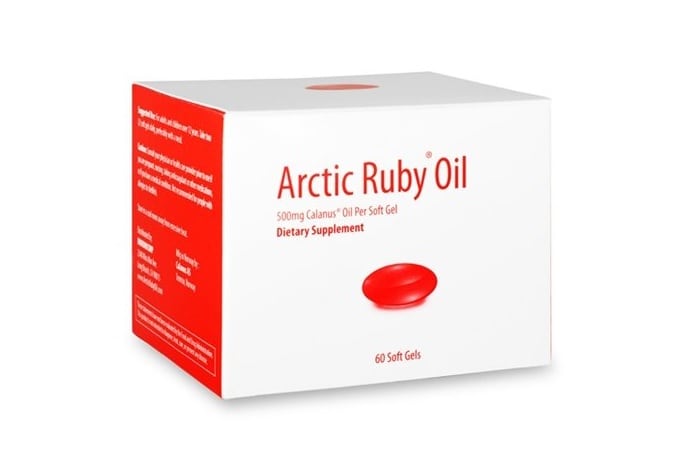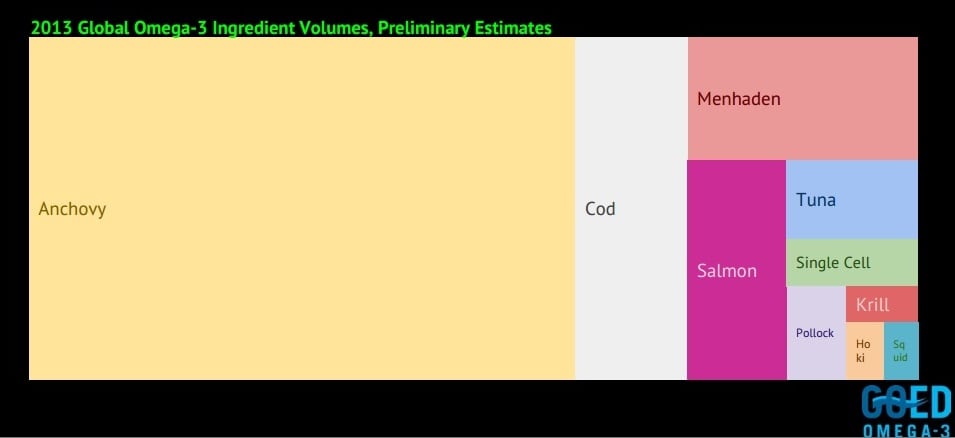Speaking with attendees at the recent GOED Exchange meeting in Salt Lake City, GOED’s Adam Ismail explained that the first generation omega-3 forms were fish oil and cod liver oil. Second generation omega-3 forms included triglycerides, methyl and ethyl esters, and phospholipid forms.
Of all the new forms making waves in the omega-3 market, omega-3 salts have the greatest potential to create a “pretty good market size”, Ismail told NutraIngredients-USA.
Omega-3 salts – soluble forms of EPA and DHA that are believed to be better absorbed – have application in both the pharma and supplement sector. Indeed, Novotech is making calcium salts from omega-3s from triglyceride oils,
Borrowing from Mother Nature
Sergej Trusov, PhD, director of research and product development for Ventura, CA-based Novotech, told us recently that the product is not microencapsulated, and the chemistry is borrowed from Mother Nature.
“The first step when the body is digesting any fatty acid is hydrolysis,” explained Dr Trusov. “We are converting omega-3s into a salt containing calcium. This is the core of our approach.”
“The main enemy of any type of organic compound and especially omega-3s is oxygen in the air. So we have found an effective and all natural system to protect our product from oxidation,” he added.
The technology offers several advantages, said Dr Trusov. It can be used with any number of fish oils including both triglyceride and ethyl ester forms (Novotech uses sardine and anchovy oils for its NovoOmega ingredient). Dr Trusov said the company has experimented using it with algal omega-3 oils and it could even be used with krill oil.
On the pharma side, Connecticut-based Thetis Pharmaceuticals is said to be developing drugs with free fatty acid omega-3s in diamine and meglumine salts for diabetics. By combining the omega-3 salts with diabetes drug metformin, it could be possible to treat both high blood glucose levels and elevated triglycerides with one tablet.
According to Ismail, the potential market for all omega-3 salts could be $1-5 billion. “Supplements are a smaller, but more tangible opportunity than pharmaceuticals,” he said.
Glycolipids
Another developing form to watch is glycolipids, in which the fatty acids are attached to carbohydrates, but are similar to phospholipids in that they are found in cell membranes, explained Ismail.
They are believed to have better bio-absorption than phospholipids because they form smaller micelles that can more easily pass through gut lumen. The area is still developing and no company is believed to be active in isolating glycolipids.

However, Israel’s Qualitas is developing an algal oil that contains omega-3s in both glycolipid and phospholipid form. Qualitas derives its algal oil from a salt water, photosynthetic species of algae called Nannochloropsis oculata. The species yields an oil rich in EPA (with no DHA) that is bound to phospholipids and glycolipids, known together as polar lipids. David Hart, VP of marketing for Qualitas, told NutraIngredients-USA that the company expects there will be 3-5 retail products with Almega PL on the market by the end of 2014.
"We appreciate the focus that Adam Ismail gave to glycolipids specifically in his presentation on the next generation omega-3s at the GOED Exchange," he said. "When we discuss Almega PL, our new algal-sourced, EPA-rich omega-3 oil, we point out that it contains 'polar lipids'. Polar lipids refer to both glycolipids and phospholipids, which have a similar hydrophilic head and hydrophobic tail structure, giving these molecules polarity and unique characteristics such as better solubility, bioavailability and incorporation into tissues/membranes. In our published clinical study, we showed that Almega PL with its polar lipids has similar total omega-3 and superior EPA bioavailability compared to krill oil (containing phospholipids).
"There is some initial research on glycolipids specifically, pointing to their intra-cellular messaging properties, anti-inflammatory benefits and the metabolic interface and synergy with phospholipids. Part of our scientific program is planning additional studies to better understand the digestion and metabolism of the glycolipids and phospholipids and omega-3 fatty acids."
The potential market for omega-3 glycolipids could be $100-150 million, said Ismail.
Wax esters
Associated with penguin, seal, and whale oil from bygone eras, wax esters may not necessarily be new, but could be making a comeback with Norwegian company Calanus extracting omega-3 wax esters from the copepods of the same name (Calanus finmarchicus).

Omega-3 wax esters are believed to have a ‘longer burn time’ than other forms of fatty acids, said Ismail, and therefore get deeper into the gut. This allows the EPA and DHA to activated specialized receptors for glucose tolerance and fat distribution thought to be in the later sections of the gut. This would open up potential blood glucose management and weight management supplement applications.
GOED’s Ismail noted that two finished products are already available containing wax esters from calanus; one in Norway and one in the US called Artic Ruby Oil.
The products are expensive compared with other omega-3 forms, retailing for between $50 and $60 per pack of 60 soft gels for the Artic Ruby Oil, because the calanus fishery is still small and requires a significant ramp-up if consumer products take off, said Ismail. If the fishery can be scaled up, a potential market opportunity of $100-500 million exists for wax esters, he predicted.
“Old patents exist on structured wax esters, so if calanus oil is successful there will likely be new competitors with alternate sources,” he added.
Others
Wax esters, glycolipids and omega-3 salts may offer the most potential for supplements, but monoglyceride forms, liposomal omega-3s, and resolvins and protectins may offer potential for medical and/ or functional foods, he said.
The later forms – resolvins and protectins – are biological derivatives of EPA and DHA and have potent anti-inflammatory and cell protection properties. They are being primarily researchers for pharmaceuticals, said Ismail. Their potential for supplements relies on answering some regulatory questions, particularly figuring out if they appear naturally in the diet. “There is still a long way to go with these in the supplement space,” he said.
What does it all mean?
While such new forms could be exciting and interesting for formulators and consumers, it is unlikely that any would steal market share from anchovy-sourced omega-3s (see chart below of 2013 global omega-3 ingredient volumes), nor will they displace anchovy oils in terms of price.
“However, some may compete for raw materials and they all present a large economic opportunity,” said Ismail.

